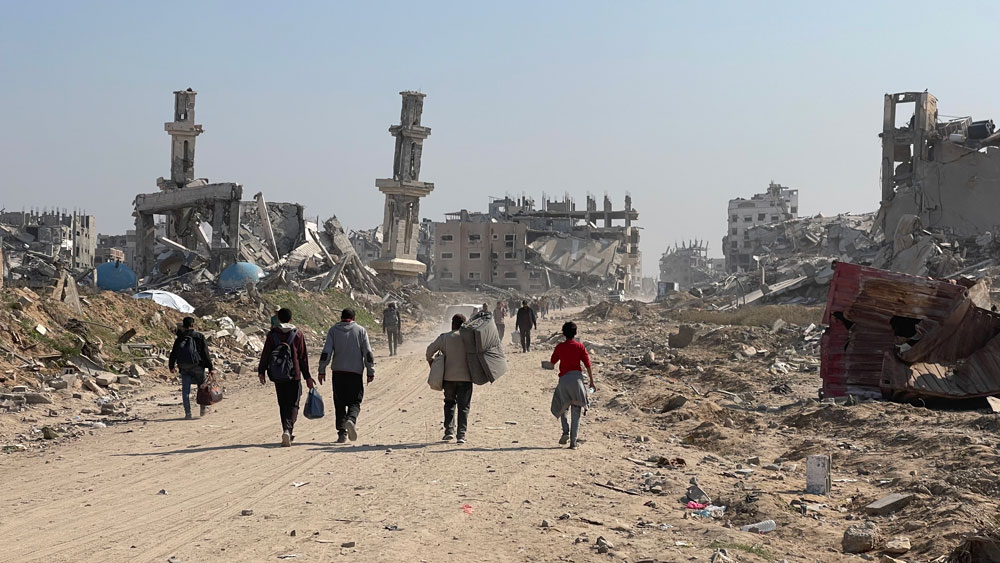
By Neta Crawford
Gaza: civilian death toll outpaces other modern wars
Neta Crawford, University of Oxford
Hamas killed about 1,200 people in Israel, mostly unarmed civilians, in its surprise attack on southern Israel on October 7 2023. Using Gaza health ministry statistics, the UN says more than 62,000 people have subsequently been killed in Gaza since Israel launched its military campaign against Hamas. An additional 1,000 Palestinians have been killed in the West Bank.
The statistics do not distinguish between combatants and civilians. But Israeli government officials have consistently said their military works hard to keep civilian harm to a minimum. As Ophir Falk, a foreign policy adviser to Israeli prime minister Benjamin Netanyahu, said in 2024: “Any civilian casualty is a tragedy for sure. Israel seeks to minimise the civilian casualties, while Hamas seeks to maximise them.”
Falk added: “We seek to minimise them for two main reasons … one, it’s the right thing to do. We’re the only Jewish country on Earth, and that is our policy to minimise civilian casualties. And the other reason is because it’s effective.” By effective, he means that hurting civilians can backfire. It can lead to a loss of domestic and international support for the war, as well as increased Palestinian resistance.
Israeli media outlets have also detailed the “extensive measures” the Israel Defense Forces (IDF) says it takes to keep civilians in Gaza safe. And they have repeated claims such as: “What the IDF has been doing in Gaza in this war is unprecedented in urban warfare, both in pace and caution.”
Israeli officials dispute the numbers of Palestinian civilians reported to have been killed in Gaza. Some have even claimed that the Gaza health ministry and UN have “lied” about the number of Palestinian civilians killed in the war.
But figures from a classified Israeli military intelligence database, reported recently by the Guardian, indicate that 83% of the Palestinians killed by Israeli forces in Gaza as of May have been civilians.
Preventing civilian harm
The protection of civilians in war has not always been taken for granted. The US only began to emphasise the minimisation of inadvertent harm to civilians, or “collateral damage”, after the Vietnam war ended in 1975.
The inadvertent killing of civilians and massacres such as My Lai, where as many as 500 unarmed Vietnamese villagers were killed by US soldiers in 1968, were widely condemned. Precautions to avoid civilian harm, known as civilian casualty or civilian harm mitigation, have been gradually integrated into US military operations since then.

Monument of the Mỹ Lai massacre in Sơn Mỹ, Vietnam. (Wikimedia Commons)
The US developed a practice of making pre-strike estimates of possible civilian harm – collateral damage estimates – in the 1990s. This was refined during the post-9/11 wars.
If civilian harm is estimated to be above a certain threshold, and disproportionate to the expected military advantage of an operation, the US military might change how it engages or not strike at all. US methods to minimise civilian casualties have been consistently updated, as recently as August 2022 and July 2024.
These precautions have not always been adhered to. They have also sometimes been relaxed when the US believes doing so is justified. But when they have been followed, the rate of civilian killing has been reduced.
The impetus for the US military to develop these programmes was not only to minimise harm to its own reputation and a desire to follow the laws of war. The point was also to avoid creating more militants by killing civilians.
The 2007 US Counterinsurgency Field Manual underscores the importance of avoiding civilian harm. It states: “an operation that kills five insurgents is counterproductive if collateral damage leads to the recruitment of 50 more insurgents.”
It was equally important to convince observers that every effort was being made to ensure civilians were protected. As a 2006 study by US-based thinktank RAND corporation, paid for by the US air force, said:
By emphasizing the efforts that are being made to reduce civilian casualties (such as increased precision, smaller blast effects, improved target verification and so on), the Air Force and Department of Defense can help ensure that the US Congress and public have continued reason to trust that the US military is seeking new ways to reduce the prospects of civilian deaths in future military operations.
A demonstrated commitment to a philosophy of continuous improvement may be what is needed to ensure this trust in the future, and in the case of foreign audiences, to build trust in the first place.
Israel also began to use some of these methods. And it developed its own, context-specific practices in its wars with the Palestinians and other neighbours. In fact, Israel was a pioneer in the use of targeted drone strikes that it said were aimed at killing Palestinian militant leaders while avoiding civilian harm.
However, investigations have shown that Israel loosened its rules of engagement after the October 7 attacks. The New York Times reported that an order by military leadership authorised officers to risk killing up to 20 people in each airstrike targeting Hamas. In one extreme example from July 2024, a strike on Hamas military leader Mohammed Deif killed at least 90 civilians and injured around 300 more.
Israel’s own military data also now shows that Israeli officials have both overstated the number of militants they say have been killed and, by implication, the ratio of civilian to militant deaths.
Prior to the Guardian’s report, Israeli officials said the military had killed 17,000 to 18,000 Hamas combatants and other “terrorists”. They also implied that 50% of the total deaths in Gaza were Hamas or other combatants. Netanyahu simultaneously decried what he called “outrageous” claims of civilian casualty rates of up to 70%.
But Israel’s own numbers show the actual civilian casualty rate in Gaza is much higher than the figure Netanuyahu calls outrageous. It is also high compared to other conflicts. Research by the Costs of War project, which I co-founded, show that the rate of civilian casualties in American wars in Iraq and Afghanistan were 68% and 26% respectively.
Civilians never deserve to be harmed through carelessness, inadvertence or deliberate targeting. Yet given the kind of war Israel is fighting – using large, indiscriminate weapons to destroy buildings and failing to distinguish between combatant and noncombatant – it has unsurprisingly produced high civilian casualty rates.
![]()
Neta Crawford is Montague Burton Chair in International Relations at Oxford University.





























JC says
Yawns. That’s what they get for having a terrorist as their official government.
Sherry says
@jc. . . Speaking like that about other human beings is beyond reprehensible and despicable! Many of those brutally “MURDERED” have been innocent children!
Hamas being in control is much more complicated than FOX says. . . Get Educated:
Hamas became the political leaders of Gaza in 2007, following their victory in the 2006 legislative elections and the subsequent armed conflict with the rival Fatah party. This culminated in Hamas seizing full control of the Gaza Strip and expelling the Fatah-dominated Palestinian Authority (PA).
1. Hamas wins the 2006 elections
In 2006, the Palestinian territories held a legislative election that international observers noted was free and fair. For the first time, Hamas participated in the parliamentary elections and won a decisive majority of seats in the Palestinian Legislative Council (PLC). Several factors contributed to this victory:
Corruption: Many Palestinians were disillusioned with the corruption and mismanagement of the long-dominant Fatah party.
Social services: Hamas had built popular support over many years by running an extensive network of social welfare programs, including clinics, schools, and daycare centers, which contrasted with the ineffectiveness of the PA.
Anti-corruption stance: Hamas ran its campaign on an anti-corruption platform, promising better governance.
Public perception of resistance: Some Palestinians viewed the 2005 Israeli withdrawal from Gaza as a victory for Hamas’s armed resistance, which boosted its credibility and popularity.
2. The international boycott
Despite the election results, the international community, including Israel, the United States, and the European Union, refused to recognize or work with the Hamas-led government. This led to a standoff with the West and crippled the new Palestinian government, which Hamas had formed with Ismail Haniyeh as prime minister.
3. Escalating tensions with Fatah
Tensions between Hamas and Fatah, which still controlled the presidency under Mahmoud Abbas, quickly escalated into a struggle for control over the security forces. Fatah forces refused to accept orders from the new Hamas-led government. In response, Hamas created its own security force, the “Executive Force,” which Abbas denounced as unconstitutional.
4. The 2007 Battle of Gaza
Factional fighting and failed attempts at a unity government culminated in the violent Battle of Gaza in June 2007. In less than a week, Hamas forces overran Fatah’s security forces, seizing control of all governmental institutions in Gaza.
Fatah expelled: Hamas fighters executed and expelled Fatah officials from the Gaza Strip.
Division of territories: After the takeover, Palestinian President Mahmoud Abbas dissolved the Hamas-led government and appointed a new one in the West Bank, effectively splitting the Palestinian territories into two separate entities.
5. Post-takeover developments
Following the Hamas takeover, Israel and Egypt imposed a blockade on the Gaza Strip, which has since led to worsening economic and humanitarian conditions. The Hamas government in Gaza has since ruled separately from the PA in the West Bank, leading to a long-running political divide.
Kennan says
Well done, Sherry!
Couldn’t have put it any better.
First of all, and I’ve said this before.
This was never a war. A super charged military response to a terrorist act. A response that said, “even though we can pinpoint Hamas; we will call it war, conflate Hamas and Palestinian civilians and kill everyone.
The IDF and Benjamin Netanyahu tried everything. They lied about Hamas hiding out under hospitals with a crude CGI rendering to justify civilian deaths.
No Hamas in tunnels under hospitals. No babies cut out of wombs! No babies in ovens! Feeble attempt by Netanyahu and not a leg to stand on.
The plan was in place the first weeks of October 2023 when water and electricity were turned off.
Hamas was put in power by Israel using Qatari money.
Every terrorist or resistance group you see today was created by the U.S., because they gave Israel land that was not theirs decades ago. A subjugation of people and APARTHEID living conditions for at least 60 years.
Quite simply “conquest through immigration.”
Oh, I almost forgot JC. You know how when you yawn you can hear everything inside your head. Everything goes quiet and you just hear the yawn? That’s a couple million of your brain cells rotting and dying while you dismiss the murder of hundreds of thousands of civilians. Countless children, And the erasure of an entire race of people.
Sherry says
Thank you Keenan! An excellent comment!
Allyn Susan Feinsetin says
[Disinformation caution: the commenter is a frequent disinformer who has been repeatedly banned previously. We have added a few links to the comment, both for context and to underscore the commenter’s tactic. Do not use this site to spread disinformation.–FL]
“Jordanian Humanitarian Aid truck driver kills soldiers at Allenby Crossing at Jordan’s Border”–jpost.com (9-18-2025). I invite folks to Google it. The Israeli soldiers were helping to dispense aid to Palestinian cvilians in need at the time rather than letting Hamas steal it all.
The story can also be found on the Arutz Sheva news website. I will be pleasantly surprised if I see The AP, Reuters, CNN or other Legacy media outlets cover the story.
To hear them tell it, Israel “targets” aid workers…that’s it and that’s all.